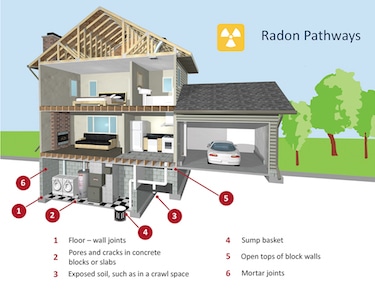“Radon is a radioactive gas that has been found in homes all over the United States. It comes from the natural breakdown of uranium in soil, rock, and water and gets into the air you breathe. Radon typically moves up through the ground to the air above and into your home through cracks and other holes in the foundation.”
Read the EPA Home Buyer’s and Seller’s Guide to Radon
“Radon is a radioactive gas. You can’t see, smell, or taste radon. It comes from the decay of radium and exists in varying amounts in most soils. High radon concentrations can be found in soils and rocks containing uranium, granite, shale, phosphate, and pitchblende. Because radon is a gas, it can move through soil and into a home. In outdoor air, radon is diluted to relatively harmless low concentrations. However, once trapped inside an enclosed space, radon can accumulate. Indoor radon levels depend upon the concentration of radon in the soil, the number of available paths into the building, and the strength of forces drawing radon into the building. Levels can vary greatly in the same town, on the same street, and from house to house.”
“How does radon enter your house? Air pressure inside your home is usually lower than pressure in the soil around and under your home. Because the pressure is lower inside, radon is sucked into your house through cracks or holes in the slab or foundation. If you have elevated radon levels you can fix your home. If you are building a house in an area of moderate or high radon potential we recommend using radon resistant building techniques.”

